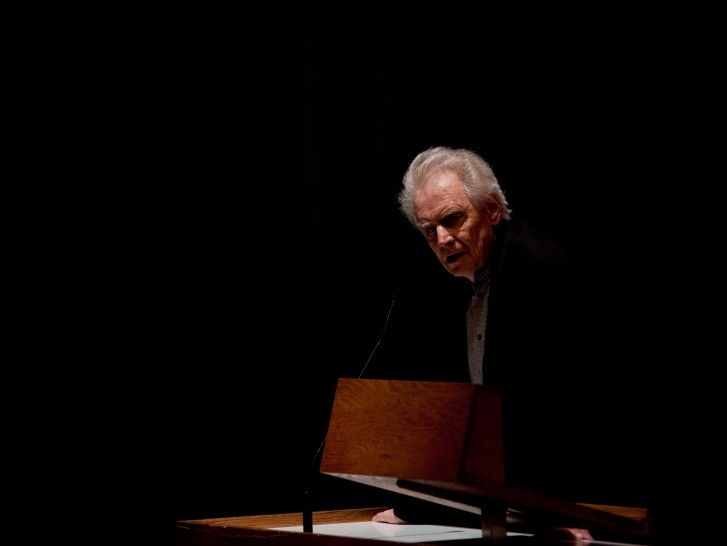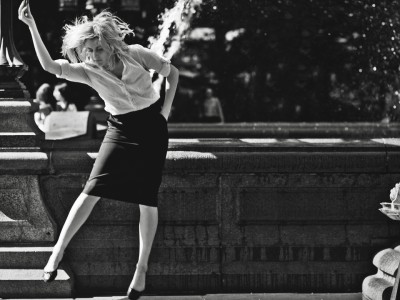
Reconversão introduction with Haden Guest and Thom Andersen.
Transcript
John Quackenbush 0:00
November 8, 2015. The Harvard Film Archive screened Reconversão. This is the audio recording of the introduction by Haden Guest and filmmaker Thom Andersen.
Haden Guest 0:13
Good evening, ladies and gentlemen. My name is Haden Guest, I'm Director of the Harvard Film Archive. I'm happy and I'm sad tonight. I'm happy because we have this amazing film to share with you, and we have with us its maker, Thom Andersen. I'm sad because this is the last of three evenings Mr. Andersen has generously shared with us. Tonight, though, we're ending on a really wonderful note, with a film from 2012 called Reconversão, which is a film that was a commission from the Vila do Conde short film festival. It's a very well known festival in Portugal, in Europe, perhaps lesser known here in the States. But in addition to its really cutting-edge curation, they also commission films. We screened a work by João Pedro Rodrigues and João Rui Guerra da Mata, Mahjong, last year, which was another one of their commissions. And for this project, Thom Andersen selected the work of the great Portuguese architect, Eduardo Souto de Moura, who is one of the most prominent architects in Portugal, a country whose architecture is probably better known for the work of Álvaro Siza Vieira. But as you'll see, the work of Souto de Moura is absolutely astonishing. Architecture has, of course, been a strong interest, even passion, we could say, of Thom Andersen's from the very beginning, as you'll see, and it is quite clear, in, of course, Los Angeles Plays Itself. But I think we can see a sensitivity to the built environment in many of his other works as well. The film, I think, is formally among one of his most bracing, shall we say. It's a structural film of sorts, and yet, it's also a wonderfully lyrical and poetic film. I won't say much about the work, much more about the work, because we have Mr. Andersen with us to introduce it. We'll also be having a conversation after the screening. And I need to thank our partners for tonight and this weekend, which is the Film Study Center here at Harvard, and I want to thank them for co-presenting Thom Andersen’s visit and retrospective. I also want to thank the Office of the Provost of Harvard University, which also gave us funding for this very, very special event. And now, with no further ado, please join me in welcoming Thom Andersen!
[APPLAUSE]
Thom Andersen 3:11
Listen, I'd like to thank Haden and David and Jeremy for inviting me here, for arranging this visit, and thank you all for coming this evening. As Haden mentioned, this was a commission. It was the first one I ever received. It was one, well, it was surprising. It was... well, maybe it's worth mentioning a few of the circumstances surrounding it. For the 20th anniversary of this festival, which is a short film festival, they had managed to get some money from the European Economic Community to commission a number of films that would all be shot in northern Portugal, which is where Porto is, the main city of northern Portugal. So a series of short films, and the only stipulation was that each film had to be shot in northern Portugal. The idea was to bring some money into the economy of northern Portugal. Not a lot of money, though. So the idea was, there would be four films by Portuguese filmmakers, and four films by filmmakers who weren’t from Portugal. And originally, they had this rather grand plan of getting, you know, famous filmmakers from all over the world to participate, which didn't quite work out. So, and maybe because the amount of the commission was not so, so much, 10,000 euros. So they asked me, and I was... you know, there were a lot of films I was interested in making for 10,000 euros, but none of those were films that would be set in northern Portugal. And I had... well, I felt, you know, believing as I do that, that, you know, filmmaking should come from locality, I had a lot of trepidation about trying myself to make a film in northern Portugal, where I'd only spent, at that time, a week. So I was thinking about what can I do? So it's true that I had always wanted to make a film about– Well, I'd wanted to make a film about architects in Los Angeles, and I had never found money to do that project. So I thought the only thing that I could do was to make a film about architecture in Porto, because it happens that Porto, although it's not a large city, is home to, you know, two winners of the Pritzker Prize, which is the big prize in architecture. One is Siza. And so the other one was Souto Moura, if I can refer to him by the name by which he’s known in Portugal, which is what I use in the film. Eduardo Souto de Moura. He had just won the Pritzker Prize. And actually, I didn't know anything about his architecture, but I thought, okay, I'll check it out. And so I got a book and I read it. I got a couple books, and I read [them], and actually, what I found most sympathetic about his architecture was the way in which he wrote about it. And the film is primarily quotations from his writings, you know, kind of presentation of the buildings through a technique that kind of– Well, for me, it's, on the one hand, it's a kind of almost a parody of HD video. On the other hand, a kind of return to proto-cinema, particularly to the work of Muybridge. It's a matter of taking still photographs and animating them. It’s the primary technique used in the film. So yeah, that worked out. And I mean, I was willing to go ahead with that idea. And so, we created a schedule, which meant I was going to be, at the beginning of 2012, over our Christmas break from school, I would have two weeks to do research, and then come back for another two weeks to shoot the film, and then edit it in a couple months after that, which was rather a tight schedule. But anyway, so the first two weeks, okay, I arrived there and, and they had assigned actually a quite wonderful woman named Raquel da Silva as the kind of line producer, and she was remarkably resourceful, but there didn't seem to have been any sort of preparation in advance for my visit. So those first two weeks kind of amounted to driving around Porto and around other parts of northern Portugal and looking for the buildings that he had designed. And then when he found one, we would knock on the door and hope that the residents would allow us in and allow us to later photograph the buildings. So that was a kind of hectic two weeks. And then the two weeks of filming seemed equally disorganized, although sometimes we had a schedule. Some days we didn't have a schedule; we wouldn't know in the morning where we were going to go film that day. But somehow it all, it all worked out. The only trouble was, of course, that I ended up not with a short film, but with a short feature film. So it cost a little more than 10,000 euros, because actually, most of that money went for just bringing myself and two other people, the cinematographer Peter Bo Rappmund and sound recordist Christine Chang, bringing the three of us to Portugal. So we didn't really have any money to make the film then. So I had to put in a little of my own money. But so, really, I had only like, I don't know, four weeks to edit it, which, before it was, before it was due to be premiered at the next festival in Vila do Conde. Which we kind of did. I mean, we had something to show. But as with the thoughts that once we had, it kind of, somehow, it wasn't quite finished. And it kind of dragged on. And I guess, I think the version you're going to see tonight is, I hope is the finished version. Or more or less finished. And really my ambition in the film was to make a Portuguese film. The only problem is that when we tried to record the narration in Portuguese, it didn't quite work. So we ended up with a English narration. So maybe someday I’ll go back and do the Portuguese version of the film, but maybe not. Anyway. So there it is. Oh, and originally the title was to be Ruins, “ruínas.” But we found out that someone else, another Portuguese... There was another Portuguese film by that title. So I ended up with this title, Reconversion, Reconversão, which is a word that doesn't actually exist in English. But well, I think even though it doesn't, you can understand what it means. And you'll see how that's one of the themes of the film. So, thank you.
[APPLAUSE]
© Harvard Film Archive




